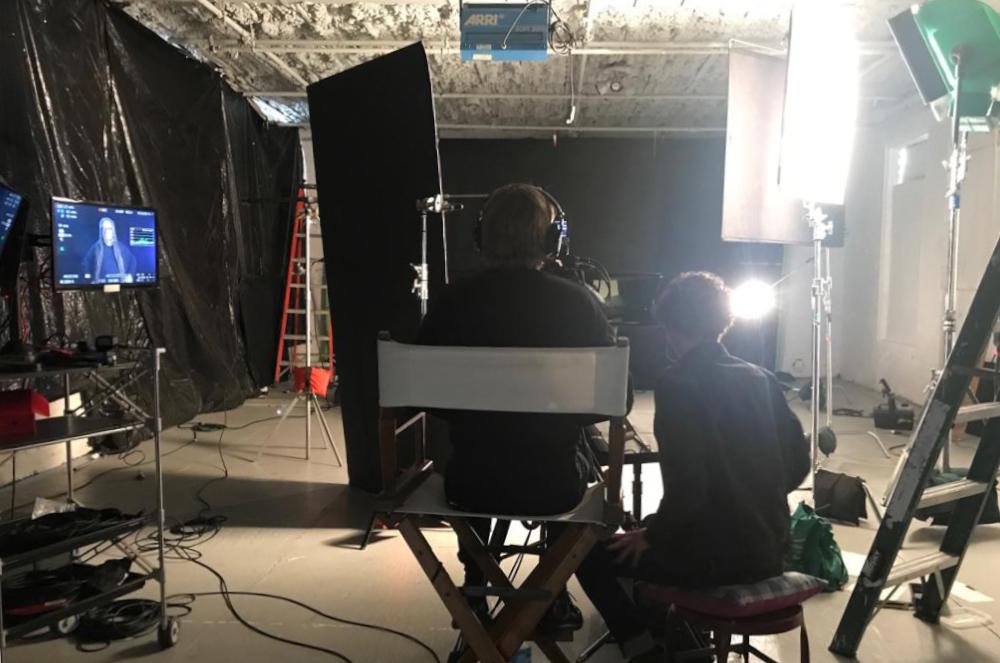
Back from that whistle-stop visit to New York. I landed Sunday and was in a perpetual state of jet-lag until I left on Wednesday.
But! It all went very well.
My colleague Laura snapped the above pic mid-shoot: your correspondent is sitting on the right and that mirror I’m peering into is a neat little device called an Eye Direct. It lets me keep eye contact with the subject while they look directly into the lens. Without it you always have to make a compromise: either you have eye contact (and therefore a more natural interview) but the subject is looking away from the lens; or you have them looking into the camera (and therefore at the audience) but they are much less comfortable.
To my left is cinematographer Michael Kirby Smith who lit the space incredibly well. I wonder, will some eagle-eyed Third Something readers recognise who we’re filming?
The series I am making has been - typical of me - intricately planned on paper. I started work on it in December and I have spent hours designing the story; the script has been through many revisions with Times editors and producers.
And yet…my plan for Tuesday was to ignore the script completely. I wanted our interview to be as free-flowing and organic as possible. I am so glad I did it this way. Our interviewee brought ideas, metaphors, turns of phrase to the table that in my wildest dreams I could not have pre-scripted.
Should I have just winged it then? Skipped the scripting entirely? No, I don’t think so.
There’s a strange paradox where, for improvisation to flourish, there must be a lot of preparation beforehand. I have heard this said by film directors (I searched through my notes for a specific quote, but came up short): they find a balance between being very well prepared for a scene, but ready to allow new ideas to emerge on set. If the actors improvise a new idea in the moment, the well-prepared director will know instantly if and how it could fit into the wider scene.
What you have then, is a process where hours of scripting and designing may not survive in the final cut.
But I would argue it is essential nevertheless. When money or time is tight, it is tempting to say “I should just skip this part” but the more I do this the more I realise how important these seemingly wasteful parts of the process are.
I started my screenplay last year by free-writing a 50,000 word short story. On its own it is bad and no-one else will ever read it - and so, ostensibly, a waste of time. And yet…writing it let me feel my way through the story as if I were fumbling around a dark room trying to establish the walls and the corners.
What should we call these parts of the process? Maybe fumbling is a good word? Exploring? I think it is about going in with an open mind and an open heart, ready for the story to tell you what it wants to be.
I got some lovely replies from last week’s letter about practice #017
Ramya, writing from India, shared a method of generating ideas from observation:
“I could be waiting for my bus, and I observe a kid walking with her mom, not looking too happy. I try to make up a story about why she’s unhappy and I usually try to come up with something quirky. If I can’t think of anything, I wait and look around for something else interesting…I keep going like this, making up a story, adding, subtracting, till I land on something funny/whimsical, which I feel I can illustrate. If not, I just chuckle at the nonsense story that entertained me while I had to wait.”
Roman made this interesting point that deliberate practice is much harder in some areas:
“Applying the principles of deliberate practice outside of established fields like sports and music is a challenge. You not only have to do the practice, but play coach as well.”
This is a smart observation and I think if you can find ways to replicate the coach then you might find practice easier. Some suggestions: communities like Skillshare often have coursework which you can get feedback on; Nathalie at the Mentorless blog runs a ‘creative detox’ where she sends you daily creative prompts for a month (in fact I see a new class starts tomorrow!); for the screenwriters in the room Scott Myer’s daily dialogue prompts are also good external motivation.
I may have given the impression that I have a really good daily practice going on at the moment. That isn’t the case at all (just in case my letter gave you pangs of insecurity) - I am still figuring out a process that works for me, so I promise to keep you in the loop.
It’s been a while since I have had a new film to share but expect a flurry of them over the next few weeks and months. Films are like buses, I guess!
In fact, this coming week two films I have had a hand in will be published by The New York Times - in the next letter I’ll share them with you and some lessons we learned making them.
Until another Sunday soon,
